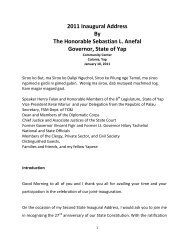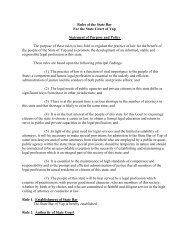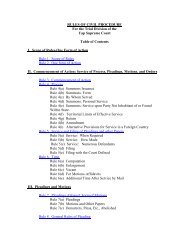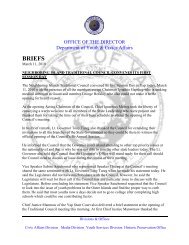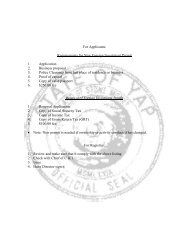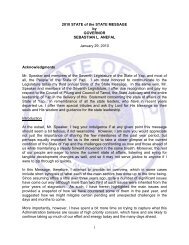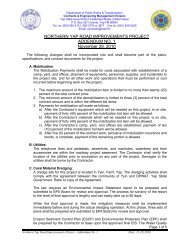CORRIGENDUM No. 2 - Yap State Government
CORRIGENDUM No. 2 - Yap State Government
CORRIGENDUM No. 2 - Yap State Government
You also want an ePaper? Increase the reach of your titles
YUMPU automatically turns print PDFs into web optimized ePapers that Google loves.
Therefore the required PV array output current is:<br />
82.2 Ah ÷ 5 PSH = 16.5 A<br />
OVERSIZE FACTOR<br />
If the system does not include a fuel generator which can provide extra charging to the battery bank then the<br />
solar array should be oversized to provide the equalisation charging of the battery bank. In Australia and New<br />
Zealand this is between 30% and 100%. It is recommended in the Pacific that this is 10%.<br />
For the worked example the adjusted array output current is:<br />
16.5A x 1.1 = 18.1 A<br />
DERATING MODULE PERFORMANCE<br />
The PV array will be de-rated due to:<br />
• Manufacturer’s Tolerance: Most manufacturers rate their modules ± a percentage (eg ±3%) or wattage<br />
(eg ±2W). Unless every module is tested and its actual rating is known then the modules should be derated<br />
by the manufacturer’s tolerance.<br />
• Dirt: Over a period of time dirt or salt (if located near the coast) can build up on the array and reduce<br />
the output. The output of the module should therefore be derated to reflect this soiling. The actual value<br />
will be dependent on the site but this can vary from 0.9 to 1 (i.e. up to 10% loss due to dirt).<br />
• Temperature: Modules’ output power decreases with temperature above 25°C and increases with<br />
temperatures below 25°C. The average cell temperatu re will be higher than the ambient because of the<br />
glass on the front of the module and the fact that the module absorbs some heat from the sun. The<br />
output power and/or current of the module must be based on the effective temperature of the cell. This<br />
is determined by the following formula:<br />
T cell-eff = T a.day + 25°C<br />
Where<br />
T cell-eff = the average daily effective cell temperature in degrees Celsius (°C)<br />
T a.day = the daytime average ambient temperature for the month that the sizing is being undertaken.<br />
Since the modules are used for battery charging, the current at 14 Volts (a good battery charging voltage) at<br />
the effective cell temperature should be used in calculations. If curves are unavailable to determine the current<br />
at effective cell temperature then use the <strong>No</strong>rmal Operating Cell temperature (NOCT) provided by the<br />
manufacturers.<br />
Therefore the derated module output current is calculated as follows:<br />
The Current of the module at 14V and effective cell temperature (or NOCT current)<br />
multiplied by derating due to manufacturers tolerance<br />
multiplied by derating due to dirt<br />
I (NOCT) x f man x f dirt<br />
If a module has a 3% (0.03) manufacturers tolerance, then the module current is derated by multiplying by<br />
0.97 (1-0.03).<br />
If a module has a 5% (0.05) loss due to dirt then the module current is derated by multiplying by 0.95 (1-0.05).<br />
For the worked example the selected module has a peak rating of 80W P .<br />
An 80 watt solar module (still used in many small off-grid systems) typically has the following data:<br />
Issue 1 September 2012 Page 8



